Circular economy in fashion: consumer awareness and lifestyle, and environmental impact on second-hand clothes
Abstract
This study aimed to identify the benefits and challenges of clothing reuse, both in terms of fashion companies collecting unwanted clothing and consumer attitudes, focusing on Japanese fashion companies and consumers To achieve the goal, this study conducts a survey to gain an overview on the supply chain of fashion brands carrying out a take-back program in Japan. This study also conducted a questionnaire survey to gage consumers’ awareness and purchasing decisions regarding second-hand clothes and to clarify the annual CO2 emissions generated by different clothing maintenance habits among second-hand clothes consumers. Business review results revealed that large companies only take back their products for reuse or recycling to control product quality. The questionnaire survey results revealed the primary motivations for purchasing second-hand clothes were financial advantages and the desire for fashionable styles. The environmental impact assessment results indicated that purchasing a second-hand shirt in the context of a circular economy produces 6.71 kg-CO2 less than buying a newly produced shirt within a linear economy (9.23 kg-CO2). Additionally, based on the questionnaire results, this study unveiled how laundry habits affect CO2 emissions during the garment use phase.


 求助内容:
求助内容: 应助结果提醒方式:
应助结果提醒方式:


